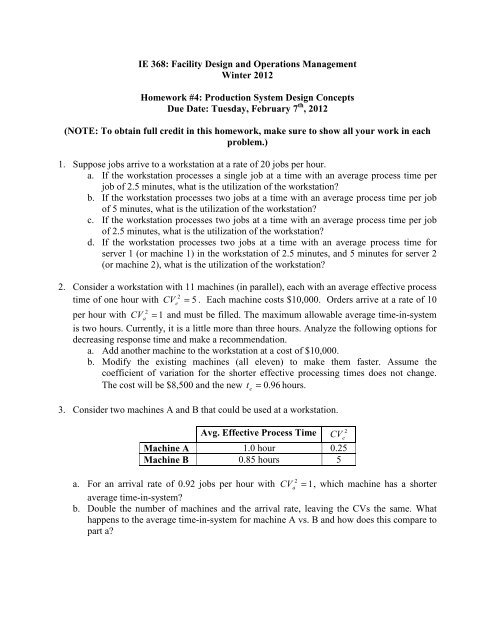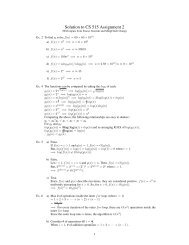Homework #4 - Classes
Homework #4 - Classes
Homework #4 - Classes
You also want an ePaper? Increase the reach of your titles
YUMPU automatically turns print PDFs into web optimized ePapers that Google loves.
IE 368: Facility Design and Operations Management<br />
Winter 2012<br />
<strong>Homework</strong> <strong>#4</strong>: Production System Design Concepts<br />
Due Date: Tuesday, February 7 th , 2012<br />
(NOTE: To obtain full credit in this homework, make sure to show all your work in each<br />
problem.)<br />
1. Suppose jobs arrive to a workstation at a rate of 20 jobs per hour.<br />
a. If the workstation processes a single job at a time with an average process time per<br />
job of 2.5 minutes, what is the utilization of the workstation?<br />
b. If the workstation processes two jobs at a time with an average process time per job<br />
of 5 minutes, what is the utilization of the workstation?<br />
c. If the workstation processes two jobs at a time with an average process time per job<br />
of 2.5 minutes, what is the utilization of the workstation?<br />
d. If the workstation processes two jobs at a time with an average process time for<br />
server 1 (or machine 1) in the workstation of 2.5 minutes, and 5 minutes for server 2<br />
(or machine 2), what is the utilization of the workstation?<br />
2. Consider a workstation with 11 machines (in parallel), each with an average effective process<br />
time of one hour with CV e2 = 5 . Each machine costs $10,000. Orders arrive at a rate of 10<br />
per hour with CV a2 = 1 and must be filled. The maximum allowable average time-in-system<br />
is two hours. Currently, it is a little more than three hours. Analyze the following options for<br />
decreasing response time and make a recommendation.<br />
a. Add another machine to the workstation at a cost of $10,000.<br />
b. Modify the existing machines (all eleven) to make them faster. Assume the<br />
coefficient of variation for the shorter effective processing times does not change.<br />
The cost will be $8,500 and the new t = 0. 96 hours.<br />
3. Consider two machines A and B that could be used at a workstation.<br />
Avg. Effective Process Time<br />
2<br />
CV<br />
e<br />
Machine A 1.0 hour 0.25<br />
Machine B 0.85 hours 5<br />
e<br />
a. For an arrival rate of 0.92 jobs per hour with CV<br />
a2 = 1, which machine has a shorter<br />
average time-in-system?<br />
b. Double the number of machines and the arrival rate, leaving the CVs the same. What<br />
happens to the average time-in-system for machine A vs. B and how does this compare to<br />
part a?
4. Consider two machines (i.e., A and B) that are used at workstations 1 and 2, respectively,<br />
arranged in series. Each workstation has a single machine.<br />
Avg. Effective Process Time<br />
2<br />
CV<br />
e<br />
Machine A 1.0 hour 0.25<br />
Machine B 0.85 hours 5<br />
For an arrival rate of 0.92 jobs per hour with CV<br />
a2 = 1, calculate the total system WIP and<br />
TIS if:<br />
a. The workstations are visited in the sequence 12.<br />
b. The workstations are visited in the sequence 21.<br />
5. Suppose in problem 4 that the sequence is 21, but now there are two machines at each<br />
workstation with a single queue feeding both machines at each workstation. The average<br />
effective processing times are double the values in problem 4, but the CVs are the same.<br />
Estimate total system WIP and TIS.<br />
6. Using the concepts of t<br />
e<br />
, ta<br />
, CVe<br />
, CVa<br />
, explain the results of the following activities on TIQ.<br />
a. Reducing the repair times at a workstation when it goes down during job processing.<br />
b. Reducing the frequency of failures at a workstation through preventive maintenance.<br />
c. Maintaining an inventory of different types of finished products to permit a similar<br />
production schedule each day.<br />
d. Producing small lots on a workstation with large setup times.<br />
e. Accepting orders for a new product (in addition to existing production) that differs (has<br />
larger times) in effective process time.
IE 368: Facility Design and Operations Management<br />
<strong>Homework</strong> <strong>#4</strong>: Production System Design Concepts<br />
Due Date: Tuesday, February 7 th , 2012<br />
Name: _______________________________________________<br />
1a) Utilization: __________________ %<br />
1b) Utilization: __________________ %<br />
1c) Utilization: __________________ %<br />
1d) Utilization: __________________ %<br />
RESULTS<br />
2a) TIS = _________________ hrs Meets requirements?: YES NO<br />
2b) TIS = _________________ hrs Meets requirements?: YES NO<br />
3a) Machine A TIS: _________________ hrs<br />
Machine B TIS: _________________ hrs<br />
3b) Machine A TIS: _________________ hrs<br />
Machine B TIS: _________________ hrs<br />
4a) Total TIS: _________________ hrs<br />
Total WIP: _________________ jobs<br />
4b) Total TIS: _________________ hrs<br />
Total WIP: _________________ jobs<br />
5) Total TIS: _________________ hrs<br />
Total WIP: _________________ jobs<br />
6) Explain your answers on your workspace.

















